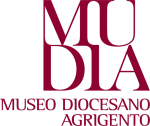CELEBRAZIONE EUCARISTICA
Dal Martedi al Sabato ore 8,30
salvo variazioni per motivi pastorali
ORARI APERTURA PER LA FRUIZIONE TURISTICA
TUTTI I GIORNI ESCLUSO IL LUNEDI DALLE
INFO ACCESSI
https://oltrelavalle.com/
3277549152 - 0922 490061

CELEBRAZIONE EUCARISTICA
Dal Martedi al Sabato ore 8,30
salvo variazioni per motivi pastorali
ORARI APERTURA PER LA FRUIZIONE TURISTICA
TUTTI I GIORNI ESCLUSO IL LUNEDI DALLE
INFO ACCESSI
https://oltrelavalle.com/
3277549152 - 0922 490061
DAL TEMPIO GRECO ALLA CHIESA CRISTIANA
Nel 480 avanti Cristo, a pochi passi dall'attuale Cattedrale di Agrigento, sorgeva maestoso un tempio dedicato aZeus Atabyrios individuato dallo storico greco Polibio. Poco più in basso rispetto a quello di Zeus, si ergeva un tempio più piccolo, probabilmente dedicato alla dea Athena. Successivamente con l’alternarsi dei secoli e dei popoli che abitarono quel territorio, del tempio più grande si persero le tracce. La base del tempio più piccolo è possibile vederla ancora oggi. Questo perché durante il periodo bizantino-arabo, a cavallo tra il 500 e l’ottocento dopo Cristo, sulle rovine del tempio di Athena, fu edificata una chiesa bizantina, l'attuale Santa Maria dei Greci.
Per le caratteristiche costruttive può essere riconducibile ai templi realizzati dopo la battaglia di Himera nel 480 a.C. per celebrare la vittoria sui cartaginesi da parte delle città greche Akragas, Siracusa, Himera e Gela. L’attuale destinazione sacra dell’area è uno straordinario esempio di continuità dei luoghi di culto dal mondo antico fino ad oggi: quello che resta dell’antico tempio greco è oggi visibile nella fondamenta della Chiesa e dal corridoio di fianco al muro perimetrale, dove si possono vedere gli antichi gradoni e il basamento (crepidoma) su cui poggiano le porzioni inferiori di sei colonne scanalate. La conversione dell’edificio classico in chiesa cristiana si pensa sia avvenuta in epoca bizantina, dedicando alla Vergine Maria il tempio pagano originariamente intitolato alla dea Atena, così come sancito dal Concilio di Efeso del 431 d.C., in linea coi decreti degli imperatori bizantini Teodosio II e Valentiniano III nel 435 d.C..
Grazie a questo decreto, con la consacrazione daparte del vescovo Gregorio II, ilcosiddetto Tempio della Concordia nella valle dei Templi, è arrivato ai nostri giorni intatto nella struttura poiché è stato usato come Basilica dedicata ai Santi e Pietro Paolo fino alla fine del 1700.
L’impianto attuale della Chiesa di Santa Maria dei Greci risale al XII-XIII secolo, mentre il portale a sesto acuto della facciata è databile XIV-XV secolo,sovrapposto a un portale precedente. La più antica pergamena della Diocesi di Agrigento ci dà notizia che nel 1092, il vescovo Gerlando, chiamato dal conte Ruggero a evangelizzare il territorio di Agrigento, mentre era in costruzione la Cattedrale, celebrava nella Chiesa di Santa Maria dei Greci,
LE VARIE TRASFORMAZIONI
La chiesetta nel periodo normanno-svevo doveva avere una dimensione più ridotta dell’attuale, a pianta centrale con cupola. L’esterno, completamente trasformato con i restauri dei primi del Novecento, doveva presentare un paramento in pietra, con intagli di arcate cieche e ghiere per le finestre, così come appare dalle foto storiche.
La pianta della chiesa doveva rientrare in un perfetto sistema geometrico che univa il cerchio e il quadrato (la dimensione astratta del cerchio, forma perfetta e infinita che incontra la forma del quadrato razionale e misurabile). Elementi bizantini e arabi fusi e divulgati dalla politica inclusiva e integrativa dei Normanni. Sin dal Duecento Agrigento fu tappa di pellegrini e soldati in viaggio verso la Terrasanta. Se ne trova testimonianze nelle tracce di un antico chiostro attiguo alla chiesa presente fino al Seicento, nelle medagliette votive ritrovate nella cripta, nonché nell’incisione della “triplice cinta”, ovvero tre quadrati concentrici tagliati da due linee ortogonali:questo simbolo mistico rappresenta l'orientamento dell'uomo nello spazio e nell'ambito vitale, l'opposizione della terra al cielo, ma può rappresentare anche l'universo creato. Il simbolo è ancora oggi visibile nell’abside nel parte interna del muro destro inciso sulla pietra.
Nel Trecentoviene fondata la Confraternita di Santa Maria dei Greci, un’associazione laica nata a supporto dei bisogni della comunità: tale presenza ha giustificato nel Seicentola creazione della cripta visibile sotto il piano di calpestio, dove venivano seppelliti i corpi dei membri della confraternita. Altre trasformazioni furono realizzate nel Quattrocento, sotto la nobile famiglia catalana dei Pujades, il cui stemma è posto sulla chiave di volta del portale d’ingresso della chiesa: viene costruito l’imponente soffitto ligneo immagini sacre di santi e sante, stemmi nobiliari, scene di vita ordinaria e vasi con frasche e realizzato il grande affresco nella navata destra con episodi della vita della Vergine, incorniciati dai rami di un eccezionale albero genealogico: esso ha origine dall’anziano Jesse, padre del re David e capostipite della stirpe da cui discende Gesù di Nazareth, raffigurato al centro dell’affresco. Nel 1726 vengono realizzate altre trasformazioni: tre piccole cupole e altri elementi architettonici aggiunti, tanto che la chiesa appariva trasformata, come ci appare dal disegno di Raffaello Politi del 1826.
Lo stato attuale si deve agli scavi e al restauro del 2005 che ha permesso di portare a vista tutto il basamento del tempio e la cripta.